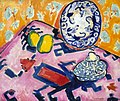Fauvism

Fauvism (French for The Wild Beasts) was the name of a modern art movement in the early 20th century, led by the painters Henri Matisse and André Derain. The Fauves were a group of French painters who were influenced by the bright colours used by the Post-Impressionists Vincent van Gogh and Paul Gauguin.[1]
The bright colourful style of painting that they used began around 1900 and continued beyond 1910, but the group was only together for three years, 1905–1907. In that time they had three exhibitions together. Their influence has continued until the present day, and was adopted or influenced many artists who are not usually thought of as fauvists. Aristarkh Lentulov is one good example.
Gallery
Fauve still life by Alfred Maurer, about 1908/1910
Fauve landscape by Alfred Maurer, around 1908
Influence of fauvism: a portrait of the Die Brücke group by Ernst Ludwig Kirchner, 1926/27
Fauvism Media
Henri Rousseau, The Hungry Lion Throws Itself on the Antelope, 1905, oil on canvas, 200 cm × 301 cm, Beyeler Foundation, Basel
Robert Delaunay, 1906, L'homme à la tulipe (Portrait de Jean Metzinger), oil on canvas, 72.4 x 48.5 cm. Exhibited at the 1906 Salon d'Autome (Paris) along with a portrait of Delaunay by Jean Metzinger
Robert Antoine Pinchon, 1904, Triel sur Seine, le pont du chemin de fer, 46 × 55 cm
Related pages
References
- ↑ John Elderfield, The "Wild Beasts" Fauvism and its affinities, 1976, Museum of Modern Art, p13 ISBN 0-87070-638-1






